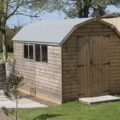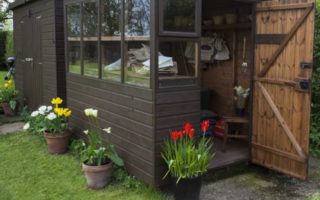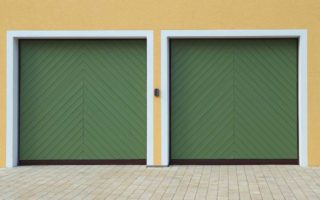
Picking the right shed door is as important as building the structure itself. Shed doors are available in a variety of designs and can also be made of different materials. Materials used will usually depend on the shed’s intended purpose. Whatever the design or type, the shed door must effectively accomplish its primary purpose, and that is to secure items stored inside the shed.
Commonly Used Traditional Shed Door Types
The use of battened doors is common in building sheds. There are three varieties of battened doors, these are:
- ledged
- ledged and braced
- framed and ledged
Ledged door
This is the simplest type of door design; it consists of wooden boards aligned vertically with three or four ledges placed in a horizontal position. Boards are put together until the desired door width is achieved. To prevent draughts from getting in, the vertical boards are joined via tongue and groove installation.
A major drawback when installing this door for outdoor use is shrinkage and swelling. It has a tendency to drop and separate at the edges away from the hinges due to changing weather conditions and constant banging when used frequently. This is why this type of door is best used indoors.
Ledged and braced
This type of door uses the same arrangement but with the added support of braces to prevent it from sagging and giving in to gravity. The brace is same as the ledges but it has to be positioned to properly slope upwards coming from the hinges to form a gallows bracket. It is best to let the brace into the ledges for more strength and support.
Framed and ledged
Among the common types of doors, this door is the strongest and the most rigid. With the full frame surrounding the door’s perimeter, it allows the door to be secured at multiple points.
Custom Shed Doors
Newer versions of shed doors are available with custom designs to accommodate specific needs as well as buyer’s preference. Common designs include:
Double doors
These are usually used in sheds where large equipment is kept. Althoug, medium sheds can also be equipped with smaller-sized double doors in case needed in the future or if preferred by the owner for easier access. This type of door consists of two doors swinging outwards and is usually made of the same material as the shed.
Sliding doors
If you have limited area for your shed, using sliding doors is an efficient way to utilize whatever space you have. As with double doors, this type also consists of two doors but instead of the doors swinging when opened and closed, they slide sideways to meet at a panel located at the center when closed. And by sliding them away from the middle panel, you open the door. It is commonly made of metal or vinyl.
Overhead doors
Also used for storing large equipment, this door coils upwards to open which can be controlled either manually or electronically. This door is usually made of metal.
Bifold door
Functions as a sliding-folding door. This type of door was originally used in cafes to let in fresh air during hot and humid weather conditions.
Personnel door
A single swinging door which is common in smaller sheds. Because this is designed for use by a person, there is not enough space for larger items to go through, which is why personnel doors are usually paired with either sliding or double doors when necessary.
Here are some easy do-it-yourself shed door plans you might want to use:
Basic Shed Door Plan (Ledged)
Choose the necessary boards according to your specified width and height. Ideally, external boards used for shed doors are 20 to 25mm thick and 125 mm wide.
- For the ledges, the width is the same but with thicker construction
- Prime the lumber before putting up the tongues and grooves as it will be inaccessible when the door is finally assembled.
- At this stage, it is normal to have the ledges on the internal side of the door. If you choose to place the ledges on the outside, bevel the surface and introduce a drip on the lower edge to direct rain water away from door as much as possible
- Start to assemble the door by placing three ledges on the back of the outer part of the batten and secure with three nails and two screws.
- Turn the batten over so that the three ledges are laid flat, with the remaining battens placed in position with the ledges.
- Attach the battens to the ledges with three to five nails placed in a zigzag fashion.
- Drive the nails in on the skew and for added security in opposite directions. Remember to put stops on the nail holes.
- The door is now ready for finishing.
Double Door Shed Plan
Materials:
- 1×6 tongue and groove lumber for the vertical door slats
- 1×4 lumber for the bracing
Procedure:
- Cut 10 tongue and groove door slats at 90 inches long.
- On a flat surface, align five slats together, with the best side facing upwards, to form a rectangular panel. At this stage, it is normal that the width of the panel is wider that the desired door width.
- Make horizontal braces by cutting three pieces of 1×4 lumber with the same width as the rectangular panel, arrange the horizontal braces and secure them using a screw to the door slates.
- Flip the rectangular panel over and measure the required door width and cut off the excess on both sides.
- Cut of the top corner at 45°.
- Again, flip the panel. Cut three 1×4 lumber to be used as diagonal or sloped braces. Measure the pieces diagonally according to the doors width and screw into place.
- First door finished.
- To make the second door, follow the same steps but with the top 45° corner cut on the opposite side from the first door.
Note that the exact door measurements should be based on the rough opening in the wall frame after the shed shell is done. A 1/4″ gap between the door and the frame should be allotted.
- Put the metal hinges on the horizontal braces of the door and secure the door in place by attaching the ends of the hinges to the trim.
- Place a door stop to the jamb around the inside perimeter of the door.








